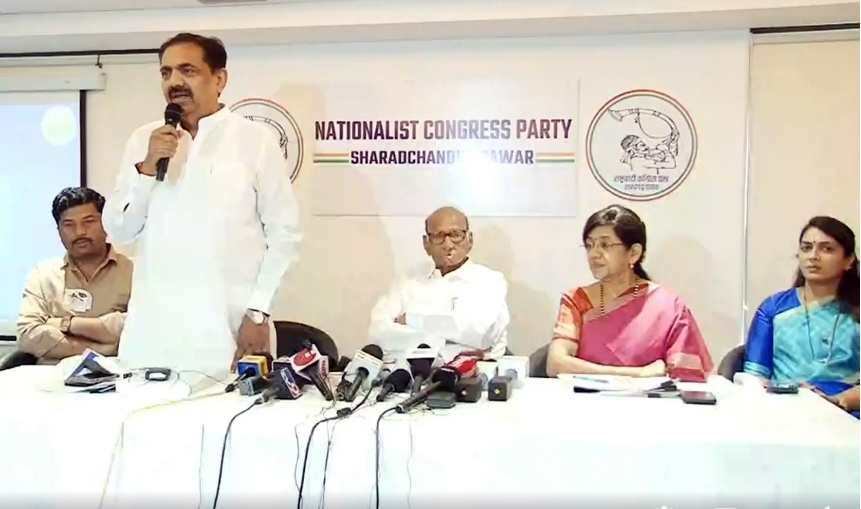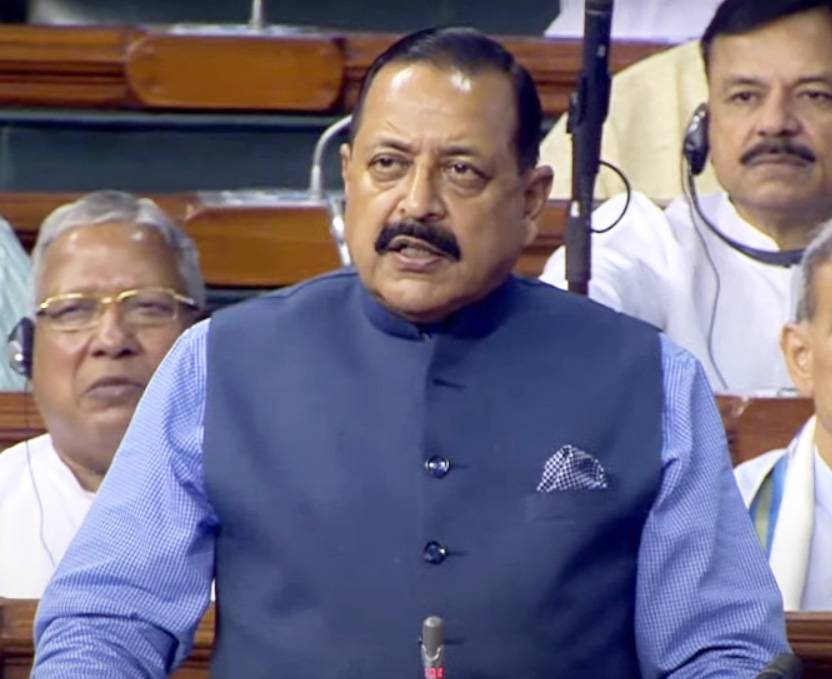A like amount shall be given as a stipend to the educated jobless youth, who will be provided free training and skilling in the government or private sector for a year and prepare them to take up jobs of their choice…reports Asian Lite News
The Nationalist Congress Party(SP) President Sharad Pawar here on Thursday released the party’s 2024 Election Manifesto with a slew of promises to attract the poor, women, farmers, the unemployed, the depressed sections of society and other backward groups for the ongoing Lok Sabha elections.
Sharad Pawar, along with state President Jayant Patil and other senior functionaries disclosed the salient aspects of the Manifesto which include an aid of Rs 1 lakh per year to a woman from all the poor families in the country under the Mahalakshmi Scheme, and help make crores of women as ‘lakhpatis’.
A like amount shall be given as a stipend to the educated jobless youth, who will be provided free training and skilling in the government or private sector for a year and prepare them to take up jobs of their choice.
Similar to the INDIA bloc proposal, the NCP(SP) will also amend the laws to hike the quotas’ ceiling and provide for reservations to more categories, set up a special farmers’ commission to advise, streamline and recommend loan waivers to the peasantry, among other things, Pawar and Patil said.
The NCP(SP) also proposes to double the income of unorganised daily workers to at least Rs 400 per day, better sops for Anganwadi women workers, throwing open the government sector’s 30 lakh jobs currently lying vacant to the unemployed youth, and other assurances for various other sections of the populace if and after the INDIA bloc comes to power.
The NCP (SP) is contesting 10 of the state’s 48 LS constituencies, with many falling in the ‘tough fight’ category, along with support from the Maha Vikas Aghadi allies like Congress and Shiv Sena (UBT).
Last week, the Congress and SS(UBT) leaders indicated that if the need arises, they might issue an MVA’s joint manifesto in the coming days.
Shiv Sena, BJP slam manifesto
Shiv Sena spokesperson Susiben Shah said the announcement of Sharad Pawar-led NCP(SP) in its manifesto ‘Shapathnama’ with regards to minimum support price (MSP) for farmers is to “deceive” and “allure” them.
“It is important to note that he was the Union Agricultural Minister for 10 years between 2004 and 2014. During his tenure, he did nothing for the farmers. The MSP announcement in the manifesto is simply an attempt to deceive and allure the farmers,” said Shah here.
“They have also shown a dangling carrot of 50 per cent reservation for women. However, the manifesto falls short in countering in leaps taken for women empowerment under the leadership of Prime Minister Narendra Modi and Maharashtra Chief Minister Eknath Shinde,” said Shah.
Offering cheap gas cylinders, and giving poor women Rs 1 lakh every year, are nothing but fake promises, she claimed.
“It is high time Sharad Pawar’s National Corrupt Party stopped cheating people and making such promises,” she said.
The BJP claimed on Thursday that the manifesto (‘Shapathnama’) released by the NCP (SP) is the biggest fraud in the world.
In Sharad Pawar’s life, a dagger is more important than the oath, said Maharashtra BJP chief Chandrashekhar Bawankule in his reaction. Due to this manifesto, the voters will not vote for the Pawar-led party, he added.
“In Maharashtra, an oath is more important than life,” he said.
“Whenever Pawar was in power, he practiced vote politics and used power to make money and again used the same money to gain power. Maharashtra never benefited due to his politics,” claimed Bawankule.
Bawankule said that Modi’s Sankalp Patra (manifesto) is for the welfare of the country. On the other hand, in the INDIA Alliance manifesto the Congress talks about the abolition of Sanatan Dharma and also on redistribution of wealth among a particular community.
Bawankuke explained the importance of oath and Sharad Pawar’s political journey. On April 26, 1645 Chhatrapati Shivaji Maharaj took the oath of Hindvi Swarajya along with his Malvas and fulfilled his oath. In 1977, the Congress party split after the Emergency. Sharad Pawar left the Indira Gandhi led Congress and joined the Congress led by Brahmanand Reddy.
He added that in 1978, Chief Minister Vasantdada Patil’s government was ousted by stabbing him in the back. In 1980, the PDF government was formed after 40 legislators rebelled and Sharad Pawar became the chief minister
According to Bawankule, in 1988, Sharad Pawar rejoined the Congress and In 1999 Sharad Pawar fell out with the Congress and formed the NCP.
In 2019, Sharad Powar gave the word to Ajit Pawar (of joining the BJP) but later overturned it. Thereafter, the Maha Vikas Aghadi government was formed in 2019.
“Really tell me, do Sharad Pawar and oath have any connection,” he asked.
The Nationalist Congress Party(SP) President Sharad Pawar here on Thursday released the party’s 2024 Election Manifesto with a slew of promises to attract the poor, women, farmers, the unemployed, the depressed sections of society and other backward groups for the ongoing Lok Sabha elections.
Sharad Pawar, along with state President Jayant Patil and other senior functionaries disclosed the salient aspects of the Manifesto which include an aid of Rs 1 lakh per year to a woman from all the poor families in the country under the Mahalakshmi Scheme, and help make crores of women as ‘lakhpatis’.
A like amount shall be given as a stipend to the educated jobless youth, who will be provided free training and skilling in the government or private sector for a year and prepare them to take up jobs of their choice.
Similar to the INDIA bloc proposal, the NCP(SP) will also amend the laws to hike the quotas’ ceiling and provide for reservations to more categories, set up a special farmers’ commission to advise, streamline and recommend loan waivers to the peasantry, among other things, Pawar and Patil said.
The NCP(SP) also proposes to double the income of unorganised daily workers to at least Rs 400 per day, better sops for Anganwadi women workers, throwing open the government sector’s 30 lakh jobs currently lying vacant to the unemployed youth, and other assurances for various other sections of the populace if and after the INDIA bloc comes to power.
The NCP (SP) is contesting 10 of the state’s 48 LS constituencies, with many falling in the ‘tough fight’ category, along with support from the Maha Vikas Aghadi allies like Congress and Shiv Sena (UBT).
Last week, the Congress and SS(UBT) leaders indicated that if the need arises, they might issue an MVA’s joint manifesto in the coming days.
Shiv Sena, BJP slam manifesto
Shiv Sena spokesperson Susiben Shah said the announcement of Sharad Pawar-led NCP(SP) in its manifesto ‘Shapathnama’ with regards to minimum support price (MSP) for farmers is to “deceive” and “allure” them.
“It is important to note that he was the Union Agricultural Minister for 10 years between 2004 and 2014. During his tenure, he did nothing for the farmers. The MSP announcement in the manifesto is simply an attempt to deceive and allure the farmers,” said Shah here.
“They have also shown a dangling carrot of 50 per cent reservation for women. However, the manifesto falls short in countering in leaps taken for women empowerment under the leadership of Prime Minister Narendra Modi and Maharashtra Chief Minister Eknath Shinde,” said Shah.
Offering cheap gas cylinders, and giving poor women Rs 1 lakh every year, are nothing but fake promises, she claimed.
“It is high time Sharad Pawar’s National Corrupt Party stopped cheating people and making such promises,” she said.
The BJP claimed on Thursday that the manifesto (‘Shapathnama’) released by the NCP (SP) is the biggest fraud in the world.
In Sharad Pawar’s life, a dagger is more important than the oath, said Maharashtra BJP chief Chandrashekhar Bawankule in his reaction. Due to this manifesto, the voters will not vote for the Pawar-led party, he added.
“In Maharashtra, an oath is more important than life,” he said.
“Whenever Pawar was in power, he practiced vote politics and used power to make money and again used the same money to gain power. Maharashtra never benefited due to his politics,” claimed Bawankule.
Bawankule said that Modi’s Sankalp Patra (manifesto) is for the welfare of the country. On the other hand, in the INDIA Alliance manifesto the Congress talks about the abolition of Sanatan Dharma and also on redistribution of wealth among a particular community.
Bawankuke explained the importance of oath and Sharad Pawar’s political journey. On April 26, 1645 Chhatrapati Shivaji Maharaj took the oath of Hindvi Swarajya along with his Malvas and fulfilled his oath. In 1977, the Congress party split after the Emergency. Sharad Pawar left the Indira Gandhi led Congress and joined the Congress led by Brahmanand Reddy.
He added that in 1978, Chief Minister Vasantdada Patil’s government was ousted by stabbing him in the back. In 1980, the PDF government was formed after 40 legislators rebelled and Sharad Pawar became the chief minister
According to Bawankule, in 1988, Sharad Pawar rejoined the Congress and In 1999 Sharad Pawar fell out with the Congress and formed the NCP.
In 2019, Sharad Powar gave the word to Ajit Pawar (of joining the BJP) but later overturned it. Thereafter, the Maha Vikas Aghadi government was formed in 2019.
“Really tell me, do Sharad Pawar and oath have any connection,” he asked.
ALSO READ-NCPA’s Living Traditions Festival Spotlights Jharkhand’s Rich Folk Heritage


















